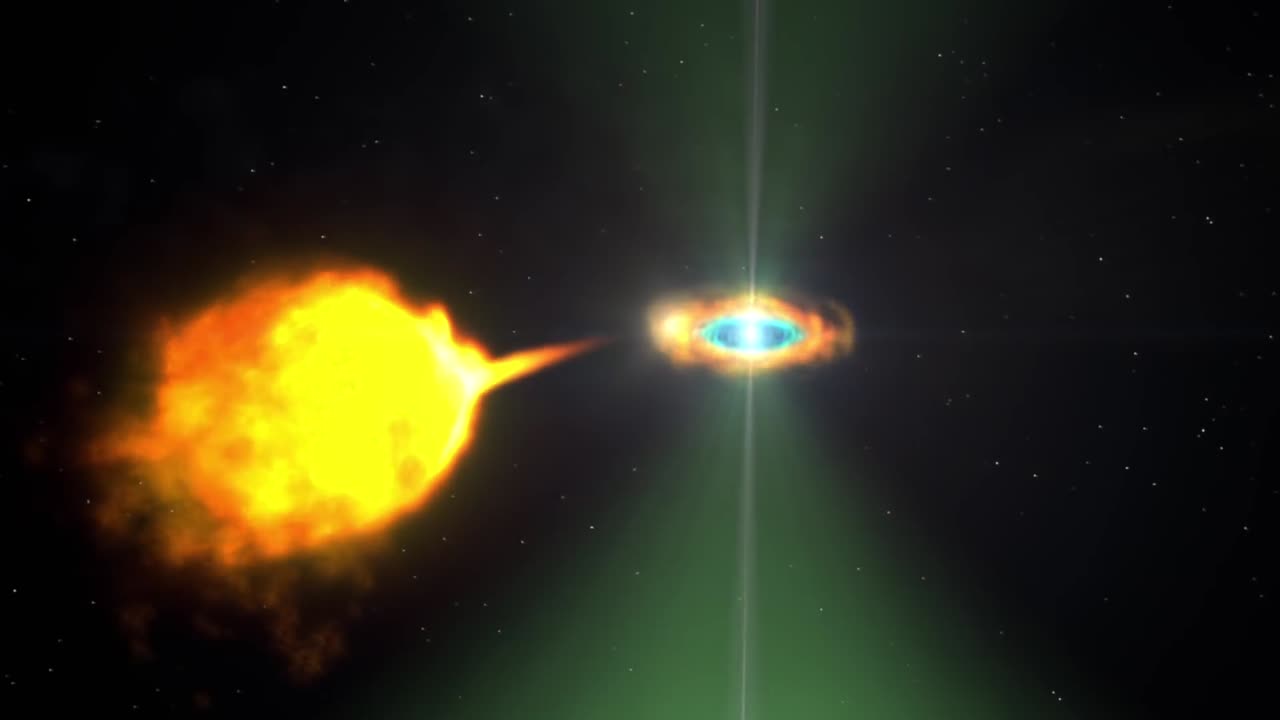Premium Only Content

NASA | Fermi Catches a 'Transformer' Pulsar
In late June 2013, an exceptional binary system containing a rapidly spinning neutron star underwent a dramatic change in behavior never before observed. The pulsar's radio beacon vanished, while at the same time the system brightened fivefold in gamma rays, the most powerful form of light, according to measurements by NASA's Fermi Gamma-ray Space Telescope.
The system, known as AY Sextantis, is located about 4,400 light-years away in the constellation Sextans. It pairs a 1.7-millisecond pulsar named PSR J1023+0038 -- J1023 for short -- with a star containing about one-fifth the mass of the sun. The stars complete an orbit in only 4.8 hours, which places them so close together that the pulsar will gradually evaporate its companion.
To better understand J1023's spin and orbital evolution, the system was routinely monitored in radio. These observations revealed that the pulsar's radio signal had turned off and prompted the search for an associated change in its gamma-ray properties.
What's happening, astronomers say, are the last sputtering throes of the pulsar spin-up process. Researchers regard the system as a unique laboratory for understanding how millisecond pulsars form and for studying details of how accretion takes place on neutron stars.
In J1023, the stars are close enough that a stream of gas flows from the sun-like star toward the pulsar. The pulsar's rapid rotation and intense magnetic field are responsible for both the radio beam and its powerful pulsar wind. When the radio beam is detectable, the pulsar wind holds back the companion's gas stream, preventing it from approaching too closely.
But now and then the stream surges, pushing its way closer to the pulsar and establishing an accretion disk. When gas from the disk falls to an altitude of about 50 miles (80 km), processes involved in creating the radio beam are either shut down or, more likely, obscured. Some of the gas may be accelerated outward at nearly the speed of light, forming dual particle jets firing in opposite directions. Shock waves within and along the periphery of these jets are a likely source of the bright gamma-ray emission detected by Fermi.
-
 LIVE
LIVE
Game On!
14 hours ago $1.34 earnedAaron Rodgers CONFIRMS with Pat McAfee he's NOT retiring... Maybe?
23,268 watching -
 37:09
37:09
Nick Freitas
22 hours agoExposing The Worst of the Swamp
26.3K16 -
 30:12
30:12
CatfishedOnline
1 day agoOnly Fans Model Drains Man's Money in Romance Scam!
14.6K9 -
 15:01
15:01
Shea Whitney
21 hours ago $1.79 earned20 *Stylish* AMAZON Closet Organization Ideas for 2025!
16.2K5 -
 16:37
16:37
IsaacButterfield
1 day ago $1.92 earnedFatTok Is Ruining Lives
15.4K18 -
 8:42
8:42
VSOGunChannel
16 hours ago $1.54 earnedDOJ Attacks the Gun Industry & ATF Gets a New Deputy Director
14K9 -
 59:47
59:47
Trumpet Daily
21 hours ago $3.32 earnedKilmar Abrego Garcia: Democrat Poster Child and MS-13 Terrorist - Trumpet Daily | Apr. 17, 2025
14.6K2 -
 8:59
8:59
MudandMunitions
18 hours agoThe Savior Equipment Range Bag: Worth the Hype or Overrated?
15.1K -
 3:06:16
3:06:16
Price of Reason
17 hours agoDESPERATE Gavin Newsom SUES Trump! Disney Fantastic Four to FLOP? Asmongold Faces BACKLASH Again!!
146K19 -
 3:48:12
3:48:12
Akademiks
10 hours agoDay 2/30. Drake Challenges UMG and calls them Desperate. Ye Backs Drake. Lil Wayne Dont Fw Superbowl
123K17